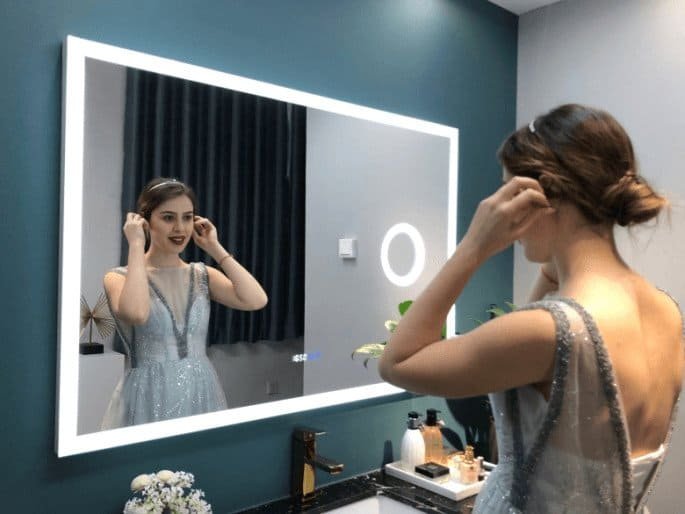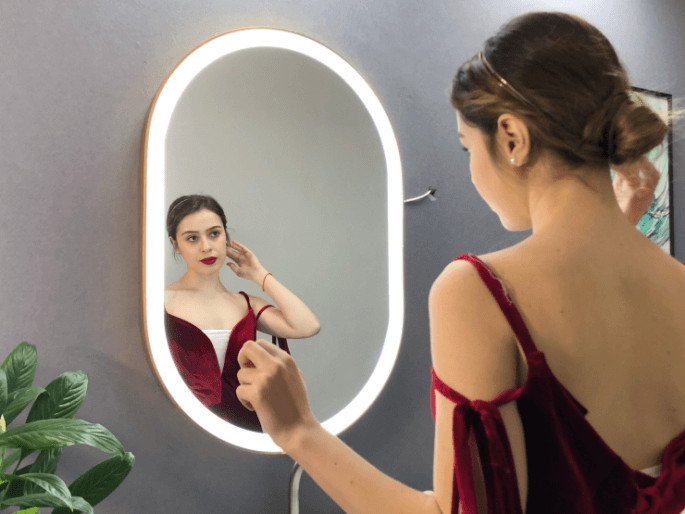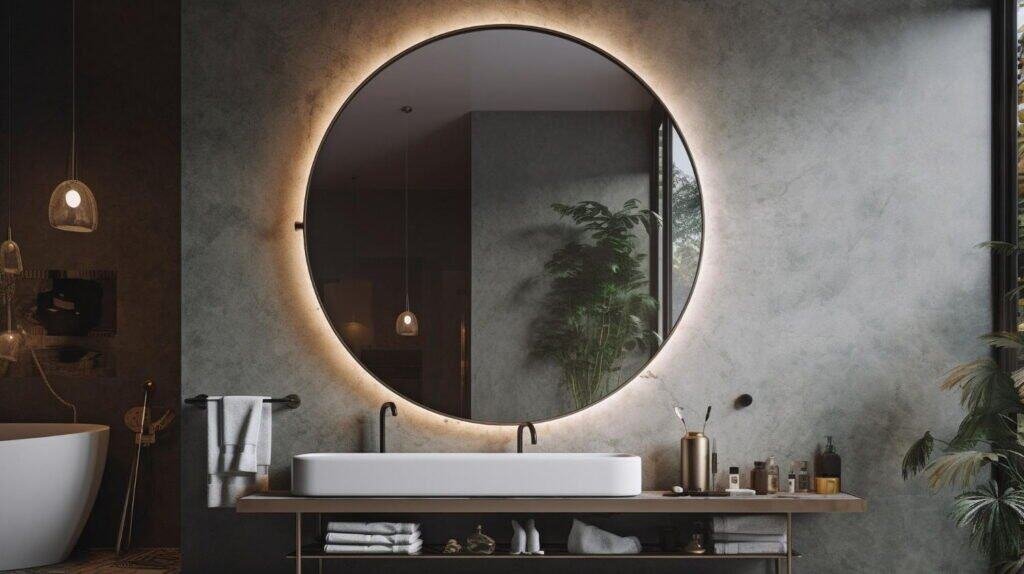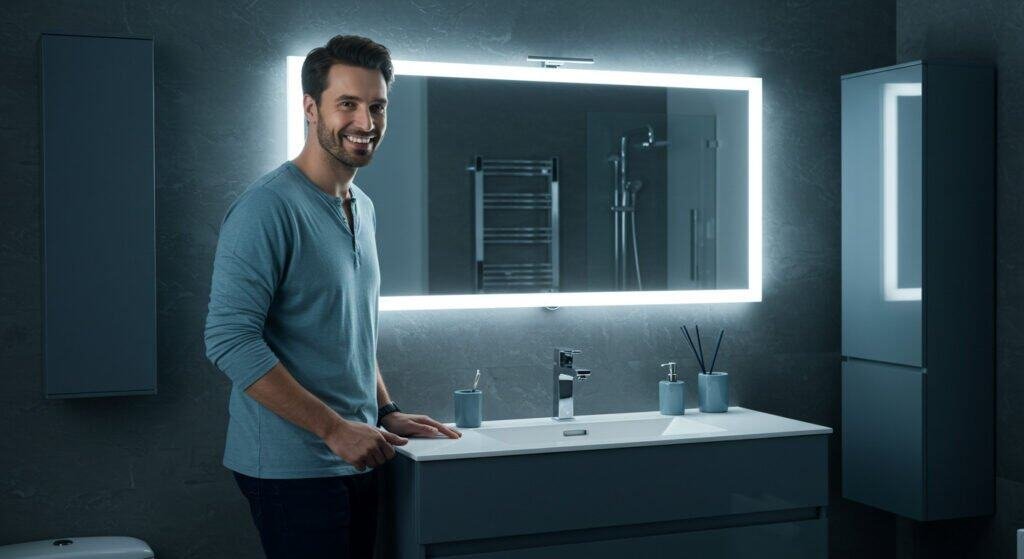What is the best mirror for bathroom?Choosing the right bathroom mirror can transform your daily routine, yet many homeowners struggle with overwhelming options and end up with mirrors that fog constantly or provide inadequate lighting.
The best mirror for bathroom applications is an LED bathroom mirror with adjustable lighting, anti-fog functionality, and customizable size options. Modern lighted mirrors for bathrooms combine superior illumination with practical features that traditional glass mirrors cannot match.
Let’s explore the essential factors that will help you make the perfect choice for your space.

What is the Best Size for a Bathroom Mirror?
Choosing the right size for your bathroom mirror directly affects its functionality and how it looks in your space
The best bathroom mirror size should be 70-80% of your vanity width, with standard rectangular bathroom mirrors measuring 24-48 inches wide for single vanities and 60-72 inches for double vanities.
Choose a small bathroom mirror that is roughly the same size as the sink and vanity to maintain visual balance. If you have a double sink, you can choose to use one large mirror or two smaller ones, but try to keep the mirror size proportionate to the size of the furniture it’s sitting above.
In commercial settings, standardized sizes mean consistent installation processes and cost-effective purchasing. But the ability to customize sizes is invaluable for adapting to unique architectural needs, especially if a construction company needs mirrors to fit their design specs perfectly.
Do You Need a Special Mirror for a Bathroom?
Yes, bathrooms require specialized mirrors designed to withstand high humidity, temperature fluctuations, and moisture exposure that would damage conventional mirrors over time.
Room mirror ideas don’t necessarily translate to the unique demands of a bathroom. A bathroom mirror is designed to handle moist conditions. How? It has moisture-resistant backing. Bathroom mirrors are also made to resist possible corrosion due to the moist conditions. They feature corrosion-proof frames. Want to avoid the black-edge side effects (the tarnishing of the silvering on the back of the mirror)? So do I. Your bathroom mirror has an anti-tarnish coating. Regular mirrors have a cardboard backing and a wood frame that will rot and corrode.
The continuous exposure to steam and humidity in bathrooms creates conditions that cause standard mirrors to develop black spots and lose reflective quality within months. Professional-grade bathroom vanity mirrors incorporate advanced materials and protective treatments that ensure longevity and maintain crystal-clear reflection quality even after years of use.
Which Type of Mirror is Best?
Understanding different mirror technologies will help you determine the best solution for your new, modern bathroom.
LED mirrors represent the superior choice for bathrooms, offering integrated lighting, energy efficiency, and advanced features that traditional glass mirrors cannot provide.
The comparison between backlit vs frontlit configurations reveals important considerations for user experience. Backlit mirrors create ambient lighting that reduces harsh shadows, while frontlit designs provide direct illumination for detailed grooming tasks. The best lighted bathroom mirror combines both approaches through dual lighting systems.
LED mirror technology provides consistent color temperature. Most offer warm white, neutral white, and cool white to provide light at different times of the day and for different activities. LED bathroom mirror technology eliminates the need for separate vanity lights. LED mirrors provide better quality lighting than traditional overhead vanity bar arrangements.

What is the Best Glass for Bathroom Mirrors?
The quality of the glass in the mirror makes a difference in how long it will last, how clear it will be, and how it will perform in your bathroom.
High-quality silver-backed glass with copper-free construction provides the best combination of clarity, durability, and moisture resistance for bathroom applications.
Standard glass mirror construction uses silver backing with copper protective layers, but copper corrodes in humid environments, leading to mirror degradation. Premium bathroom mirrors utilize copper-free silver backing with advanced protective coatings that resist moisture penetration and chemical damage from cleaning products.
Another thing to consider is the thickness of the glass. Four to six millimeters is the thickness that you want to have for optimal durability, yet you don’t want it to be so heavy that it’s hard to hang on the wall. You must also think about anti-corrosive edge sealing. Moisture comes up from the bottom of a mirror, not down from the top. The first place a mirror fails in a high humidity environment is at the bottom, and if it’s not sealed correctly, that’s where your problems are going to start.
How to Choose a Mirror for Bathroom?
Systematically consider all these factors to make sure you are getting the best bathroom mirror for your situation.
Choose bathroom mirrors by evaluating size compatibility, lighting requirements, feature needs, installation constraints, and budget parameters while prioritizing moisture resistance and durability.
Start by measuring the width of the vanity and the width of the available wall space where you can hang a mirror. The next thing to think about is ceiling height since that’s going to be a key factor in determining how big you need the mirror to be. How much light do you need? Well, that’s going to be determined by how much natural light is in the room, how good your existing vanity lights are, and the quality of light you need for activities such as shaving or applying makeup.
Feature prioritization should include essential functions like defogging capabilities for humid environments and optional enhancements such as Bluetooth connectivity or magnification zones. Installation considerations encompass wall mounting requirements, electrical connections for lighted vanity mirrors, and accessibility compliance for commercial applications. Quality certification verification ensures products meet safety standards and performance expectations.
How to Pick Out a Bathroom Mirror?
You must carefully evaluate what your needs are and what sort of performance you expect over time from your new bathroom mirror.
Pick bathroom mirrors by examining build quality, testing lighting performance, verifying certifications, evaluating supplier reliability, and confirming warranty coverage before purchase decisions.
When you look at a mirror, look at the construction of the frame (this is especially true with black frame mirrors as scratches and wear show up more on these mirrors than on others). Run your fingers around the edges of the frame and make sure it’s built well. The second thing to evaluate on a lighted makeup mirror is how well the color temperature adjustment works, how responsive the brightness control is, and how evenly the light is distributed.
Certification verification covers electrical safety standards, moisture resistance ratings, and quality management system compliance. Supplier assessment encompasses manufacturing capability, customization flexibility, logistics reliability, and technical support availability. For business applications, establishing clear quality control procedures and delivery schedules prevents project delays and ensures consistent product quality across large orders.

What are the Disadvantages of LED Mirrors?
Understanding LED mirror limitations helps set appropriate expectations and mitigation strategies.
LED mirror disadvantages include higher initial costs, potential electronic component failures, and complexity in repairs compared to traditional mirrors.
Cost considerations don’t just stop at the cost of buying the mirror. You also have to think about the complexity of installing the mirror. When you’re installing an LED lighted mirror, now you’re running electrical, which means you’re bringing more electronics into the equation, which is another problem. The nice part about a quality LED lighted mirror is that you won’t have a problem with the light source for a long time. A quality LED lighted mirror will last over 50,000 hours before you’ll notice any degradation in the light.
Repair complexity increases when integrated electronics fail, often requiring complete unit replacement rather than simple repairs possible with traditional lighted vanity mirrors for bathroom applications. However, these disadvantages are offset by energy efficiency, enhanced functionality, and elimination of separate lighting fixtures. Selecting established manufacturers with comprehensive warranty coverage and technical support minimizes potential issues and ensures reliable long-term performance.
What are the Negative Effects of LED?
Understand that there are some things you won’t be able to do with an LED lighted mirror.
LED negative effects include potential blue light exposure, color rendering variations, and flickering in lower-quality products that may cause eye strain.
Therefore, when choosing a vanity mirror for your bathroom or dressing area, make sure to look for one that offers warm light options and adjustable color temperature settings to minimize blue light exposure during evening use.
Color rendering index variations can affect makeup application accuracy, making high-CRI LED selection crucial for vanity mirror with led lights applications. Flicker concerns primarily affect low-quality LED drivers, emphasizing the importance of selecting products with stable power management systems. Quality LED mirror manufacturers address these concerns through advanced LED technology, proper thermal management, and comprehensive testing protocols.

What are the Disadvantages of Smart Mirrors?
Smart mirrors introduce an additional level of complexity that may not be suitable for everyone or every application.
Smart mirror disadvantages include increased complexity, higher maintenance requirements, potential connectivity issues, and privacy concerns with integrated cameras and microphones.
The level of technical complexity goes through the roof the minute we start talking about smart features. You need a stable internet connection, you need to worry about software updates, and you need to be able to troubleshoot the mirror when it doesn’t work the way it’s supposed to. And then there are the privacy concerns. Are there cameras in the mirror for virtual try-on and makeup application? Is the microphone always on for voice-activated commands?
Maintenance requirements expand beyond simple cleaning to include software management, connectivity troubleshooting, and component replacement for failed sensors or displays. For commercial applications, smart mirrors may introduce security vulnerabilities and compliance challenges that standard lighted bathroom mirror solutions avoid entirely. Cost-benefit analysis often favors LED mirrors with essential lighting and defogging features over complex smart mirror systems for most bathroom applications.
Conclusion
The best bathroom mirrors are the ones that have LED lighting, moisture resistance, the right size for the space, and they’re guaranteed not to rust. I hope you can start to see the different between just a plain bathroom mirror and a mirror you can use with your smart bullets.
- Clik here to know What Is Copper Free Mirror?
- If you donot know how too choose the right bathroom height click here.
- Know more about LED bathroom mirror Problems
- Clik here to know why Touch Sensor Mirror Not Working
- Clik here to know What Are Standard Vanity Mirror Sizes?
- Clik here to know Why Are Mirrors So Expensive?
- Clik here to know Do LED Mirrors Need Electricity?
- Clik here to know Is a Lighted Mirror Enough Light for a Bathroom?
- Find out 10 Common LED Bathroom Mirror Problems Click Here



